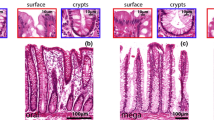Abstract
Proteases play a key role in the physiological processes of the small intestine, supporting its normal physiological functions as a part of the digestive system, in which hydrolysis and assimilation of nutrients are implemented. A high concentration of antigens in the intestinal lumen activates immunity and stimulates a chronic weakly expressed inflammatory response in a normal gastrointestinal tract (GIT). Cathepsin G, a serine protease controlling the functional state of immune cells, directly participates in the complicated system for the regulation of balance between physiological and pathological inflammations. To determine the role of cathepsin G in the small intestine, an immunofluorescent investigation of biopsies from the human duodenal mucosa were investigated using the confocal immunofluorescence microscopy method and human antibodies to cathepsin G. It has been shown for the first time that cathepsin G, which was regarded conventionally as one of the effectors of the inflammatory process, is a constitutive enzyme of the human duodenum and is constantly present in its normal mucosa. The new cell sources for the cathepsin G biosynthesis identified: intraepithelial lymphocytes (IELs), lamina propria lymphocytes, CD14-positive intestinal macrophages, and Paneth cells, which are specialized epitheliocytes of intestinal glands. Our data on the cathepsin G expression by immunocytes and Paneth cells in the duodenum allow us to attribute cathepsin G to the main proteases of intestinal immunity, which indicates the important role of this enzyme in the regulation of human GIT functions.
Similar content being viewed by others
References
Zamolodchikova, T.S., Serine proteases in immune protection of the small intestine, Biochemistry (Moscow), 2013, vol. 78, no. 3, p. 213.
Meyer-Hoffert, U., Neutrophil-derived serine proteases modulate innate immune responses, Front. Biosci., Landmark Ed., 2009, vol. 14, p. 3409.
Zamolodchikova, T.S., Shcherbakov, I.T., Khrennikov, B.N., and Svirshchevskaya, E.V., Expression of duodenase-like protein in epitheliocytes of Brunner’s glands in human duodenal mucosa, Biochemistry (Moscow), 2013, vol. 78, no. 8, p. 954.
Pugin, J., Heumann, I.D., Tomasz, A., et al., CD14 is a pattern recognition receptor, Immunity, 1994, vol. 1, no. 6, p. 509.
Cheroutre, H., Lambolez, F., and Mucida, D., The light and dark sides of intestinal intraepithelial lymphocytes, Nat. Rev. Immunol., 2011, vol. 11, no. 7, p. 445.
Schmitz-Moormann, P., Schmidt-Slørdahl, R., Peter, J.H., and Massarrat, S., Morphometric studies of normal and inflamed duodenal mucosa, Pathol., Res. Pract., 1980, vol. 167, nos. 2–4, p. 313.
Wang, J., Sjöberg, S., Tang, T.T., et al., Cathepsin G activity lowers plasma LDL and reduces atherosclerosis, Biochim. Biophys. Acta, 2014, vol. 1842, no. 11, p. 2174.
Burster, T., Macmillan, H., Hou, T., et al., Cathepsin G: Roles in antigen presentation and beyond, Mol. Immunol., 2010, vol. 47, no. 4, p. 658.
Schenk, M. and Mueller, Ch., Adaptations of intestinal macrophages to an antigen-rich environment, Semin. Immunol., 2007, vol. 19, no. 2, p. 84.
Kurashima, Y., Goto, Y., and Kiyono, H., Mucosal innate immune cells regulate both gut homeostasis and intestinal inflammation, Eur. J. Immunol., 2013, vol. 43, no. 12, p. 3108.
Clevers, H.C. and Bevins, C.L., Paneth cells: Maestros of the small intestinal crypts, Annu. Rev. Physiol., 2013, vol. 75, p. 289.
Tang, Q.J., Wang, L.M., Tao, K.Z., et al., Expression of polymeric immunoglobulin receptor mRNA and protein in human paneth cells: Paneth cells participate in acquired immunity, Am. J. Gastroenterol., 2006, vol. 101, no. 7, p. 1625.
Hasan, M., Hay, F., Sircus, W., and Ferguson, A., Nature of the inflammatory cell infiltrate in duodenitis, J. Clin. Pathol., 1983, vol. 36, no. 3, p. 280.
Kamada, N., Hisamatsu, T., Okamoto, S., et al., Unique CD14 intestinal macrophages contribute to the pathogenesis of Crohn disease via IL-23/IFN-gamma axis, J. Clin. Invest., 2008, vol. 118, no. 6, p. 2269.
Akula, S., Thorpe, M., Boinapally, V., and Hellman, L., Granule associated serine proteases of hematopoietic cells–an analysis of their appearance and diversification during vertebrate evolution, PLoS One, 2015, vol. 10, no. 11, p. e0143091.
Pang, G., Buret, A., and Batey, R.T., Morphological, phenotypic and functional characteristics of a pure population of CD56+ CD16-CD3-large granular lymphocytes generated from human duodenal mucosa, Immunology, 1993, vol. 79, no. 3, p. 498.
Dabek, M., Ferrier, L., Roka, R., et al., Luminal cathepsin G and protease-activated receptor 4: A duet involved in alterations of the colonic epithelial barrier in ulcerative colitis, Am. J. Pathol., 2009, vol. 175, no. 1, p. 207.
Dzau, V.J., Gonzalez, D., Kaempfer, C., et al., Human neutrophils release serine proteases capable of activating prorenin, Circ. Res., 1987, vol. 60, no. 4, p. 595.
Shorning, B.Y., Jardé, T., McCarthy, A., et al., Intestinal renin-angiotensin system is stimulated after deletion of Lkb1, Gut, 2012, vol. 61, no. 2, p. 202.
Wong, T.P., Debnam, E.S., and Leung, P.S., Involvement of an enterocyte renin-angiotensin system in the local control of SGLT1-dependent glucose uptake across the rat small intestinal brush border membrane, J. Physiol., 2007, vol. 584, p. 613.
Author information
Authors and Affiliations
Corresponding author
Additional information
Original Russian Text © T.S. Zamolodchikova, I.T. Shcherbakov, B.N. Khrennikov, B.B. Shoibonov, E.V. Svirshchevskaya, 2017, published in Fiziologiya Cheloveka, 2017, Vol. 43, No. 3, pp. 102–110.
Rights and permissions
About this article
Cite this article
Zamolodchikova, T.S., Shcherbakov, I.T., Khrennikov, B.N. et al. Cathepsin G in the immune defense of the human duodenum: New sources for biosynthesis. Hum Physiol 43, 326–333 (2017). https://doi.org/10.1134/S0362119717020177
Received:
Published:
Issue Date:
DOI: https://doi.org/10.1134/S0362119717020177




